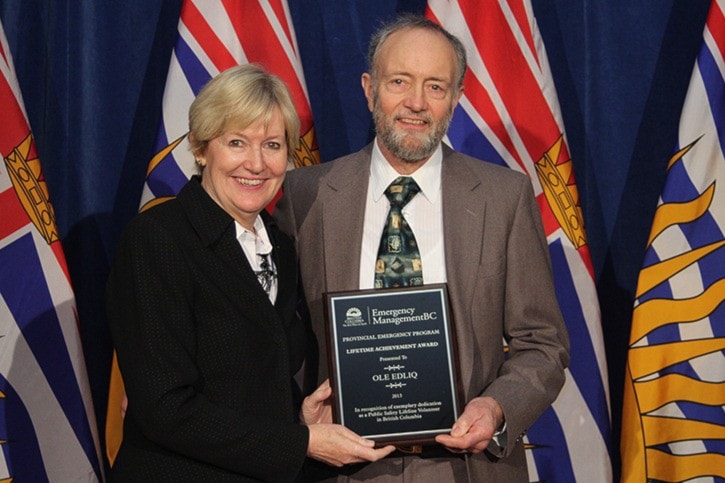When Ole Edliq moved to British Columbia, he really wanted to explore the province's vast mountains, but little did he know at the time, that curiosity would translate into provincial recognition for his volunteer service.
Edliq was one of a handful of Public Safety Lifeline Volunteers recognized last week with a formal presentation at the legislature by Attorney General and Minister of Justice Suzanne Anton.
"It's been so amazing to get this type of recognition from fellow rescue members," said Edliq.
The Danish-born rescuer received the Lifetime Achievement award during the ceremony, which sees volunteers recognized for their outstanding contributions in disaster response and public safety.
"It was a really big surprise," added Edliq of the award. "It was really heartwarming to see. In the parliament building during the ceremony, what greeted me was my whole family was there."
In 1967, Edliq immigrated from Denmark to Canada, and, inspired by the mountains in nearby Norway, he "was curious about mountains, and I thought B.C. would be the ideal spot."
Because of Danish military conscription, Edliq enlisted in civil defence, which he explained specialized with helping people in times of need, particularly when disaster strikes.
"Teams in B.C. go out and help those in times of need," he added.
As the government at the time instructed where immigrants were to land, Edliq first came to Halifax, then Montreal, and in 1968, eventually made his way to B.C.
He began volunteering with North Shore Rescue in North Vancouver, where he explained, "The criteria to join was quite different from what they are now."
To become a member, Edliq noted he was required to walk on all three North Shore mountains, both during the day and night, with a map or compass.
"You really get to know them," he said. "I then starting learning first aid and rope skills."
Edliq now specializes in human tracking during searches, and explains not a lot of searchers will look upwards during a rescue.
"Humans walk a lot differently than animals. Therein lies the secret," he said. "To find evidence of a passage, it's a good idea to walk forward, then look behind you. You see things a lot differently. You must have a keen eye and a lot of patience."
Upon moving to the Comox Valley and building his home with his wife, Edliq read about the Comox Valley Ground Search and Rescue organization, and knew he wanted to join.
Thirty-seven year later, he reflects on the changes of search and rescue organizations.
"Now, because of required certifications, you have to have a lot of training and certificates before (you can participate in a search). There are a lot of restrictions if you don't keep up with training," he said.
Edliq added one of the biggest challenges for CVGSAR is to entice young people to join, both due to the time commitment and cost of equipment and training.
Despite the challenges, he credits both his fellow CVGSAR volunteers and those throughout the Comox Valley for their dedication to those in the community.
"Where would the community be without the all of the volunteers?"
photos@comoxvalleyrecord.com
